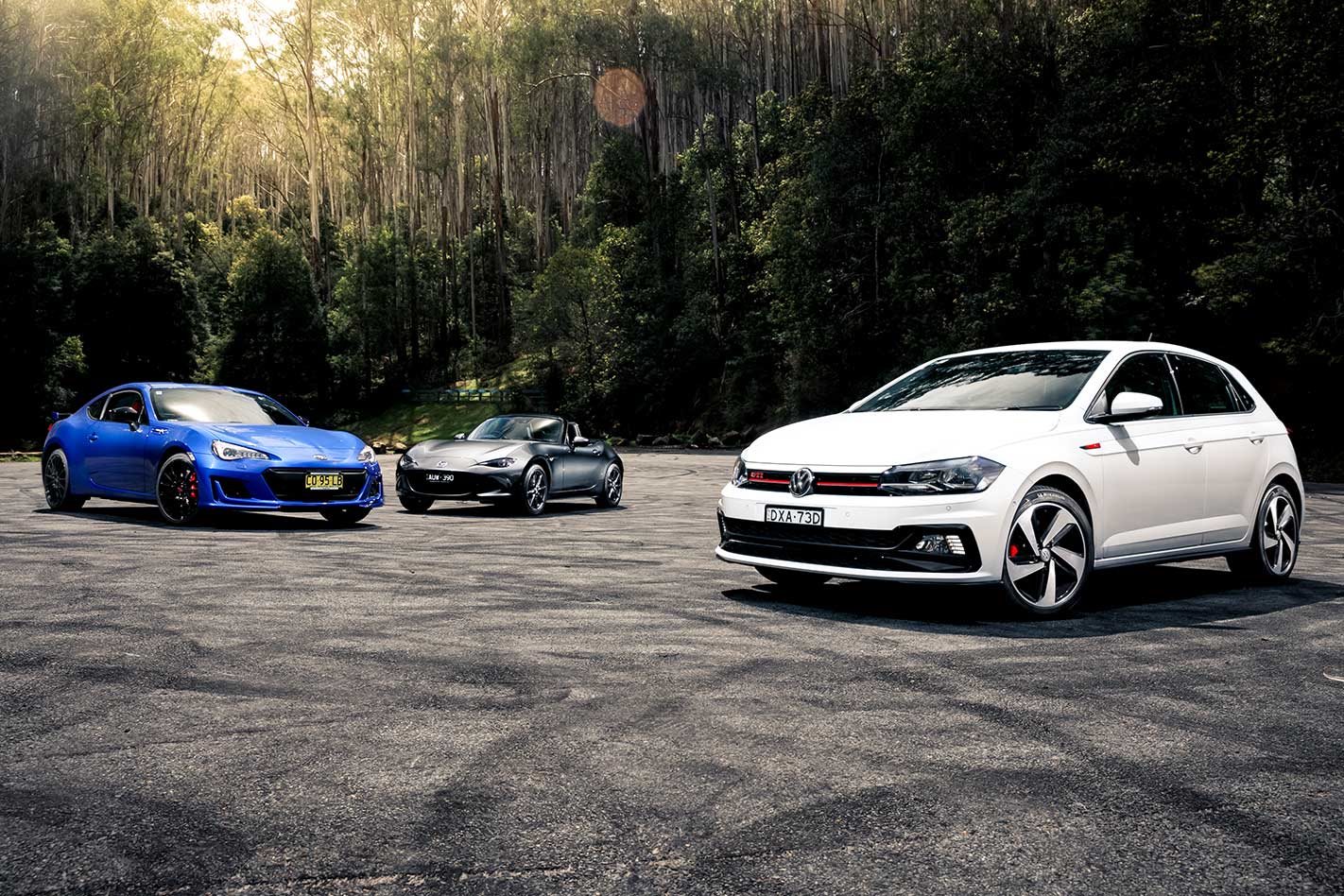Flat! We’ve just held a third-gear left-hander flat. The revs were straining against gravity and it felt like the car’s door handles had almost scraped along the road lines. Okay, so there was a little lift leading into it, and it’s on an incline, but this Mazda MX-5 held the bend like Mark Webber’s 2012 Red Bull at Eau Rouge.

The MX-5 is not the only car here with aspirations of the same sort of heroics. The recipe for cars under $50K with a performance bent is now a familiar one: light weight, modest power and tenacious handling. And the two rivals waiting for the MX-5 at the turnaround point are prime examples.
The Subaru BRZ, along with its Toyota twin, has spiritually succeeded the Nissan 200SX as a ‘cheap’ option for the opposite-lock obsessed. Then, just when we were thinking it was aging gracefully, starting to accept its economy tyres and flawed engine, Subaru lobbed the tS. It’s the handling-focused version that promises to be the best of the lot.
Meanwhile, the Volkswagen Polo GTI parked next to it doesn’t feature rear-wheel drive or a coupe shape, but it asks if all that is necessary. Just when you thought the 1.8-litre ‘big-block’ version before it was the Polo reaching the height of its powers, VW has thrown the kitchen sink, drying rack and towel at the new sixth-generation car.
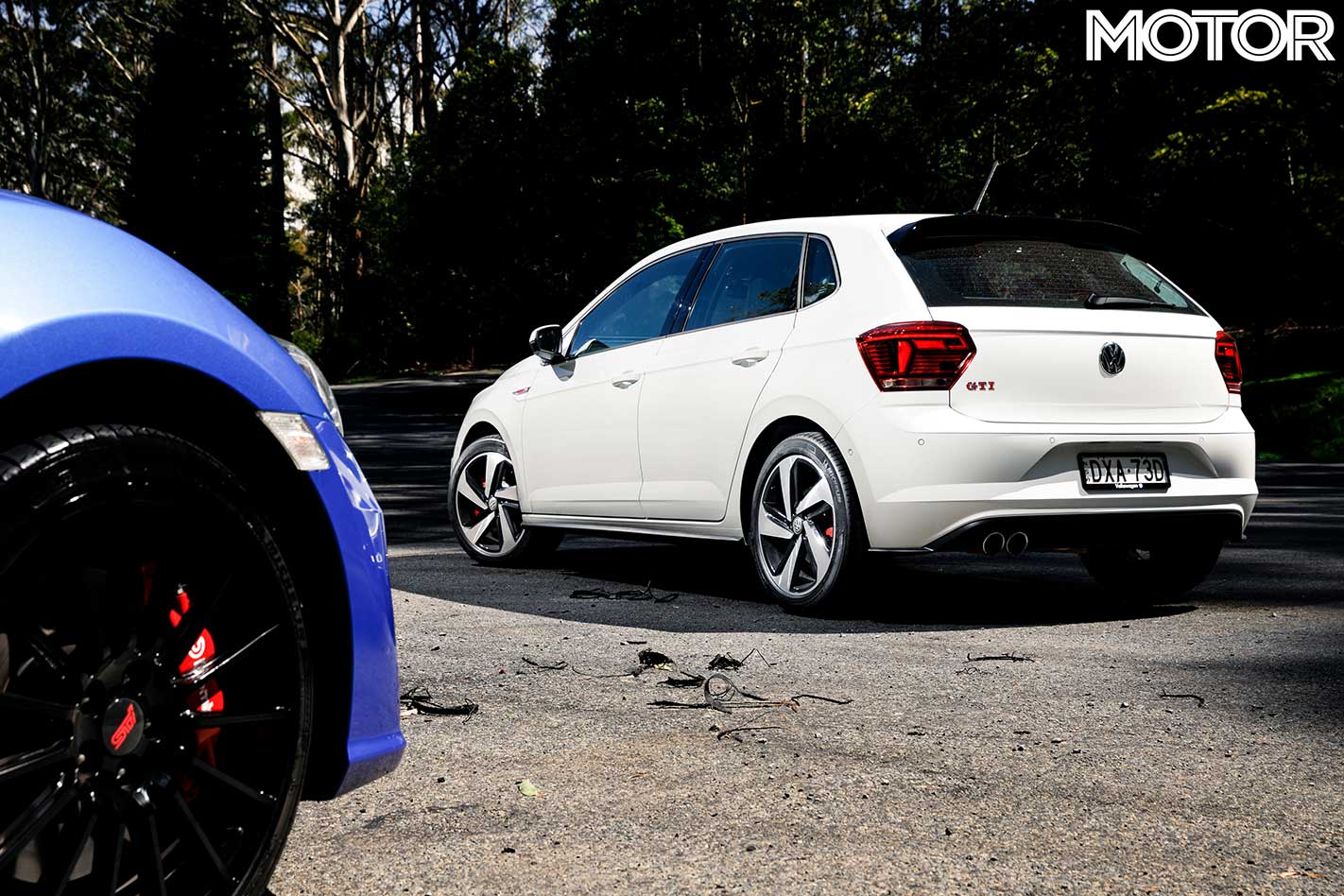
With a bigger 2.0-litre turbo four in its nose it promises to kick some heads in a straight line, but will it be nimble enough in a bigger body? We’ll find out.
We thought Mazda gave the 1.5-litre MX-5 a sky-high redline so it had a chance on the showroom floor next to the 2.0-litre version. But now it has worked on the larger engine to rev just as hard, sound just as good and feel more playful.
Better yet, while a Fiat Abarth 124 Spider seems like a better pick in the world of cut-price roadsters with its Bilstein suspension, Brembo brakes and turbo four-cylinder, the 2019 2.0-litre MX-5 is more powerful than its Italian cousin because it’s been tweaked with newfound free-breathing sorcery.
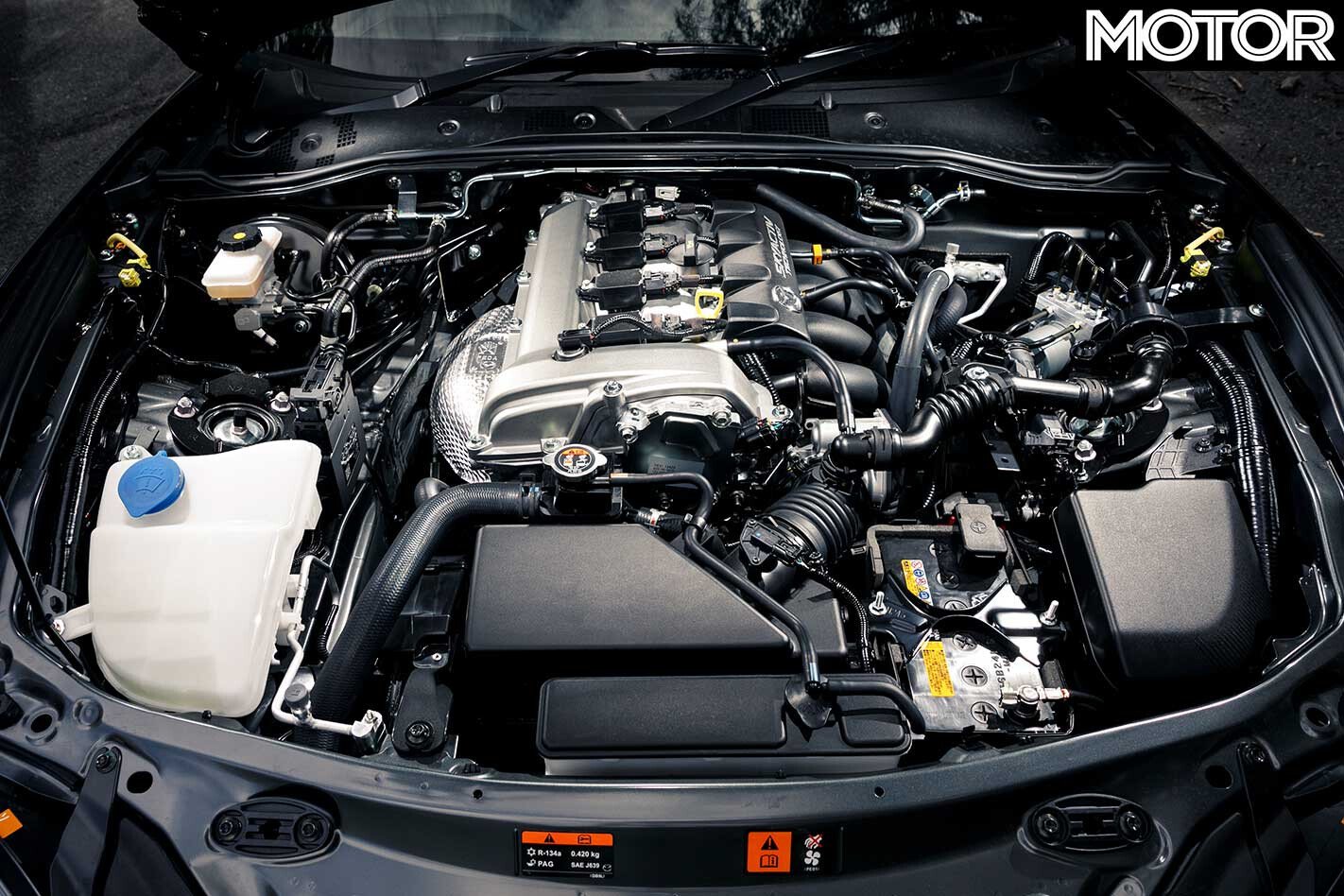
The MX-5’s intake and exhaust paths are upgraded, its internals have been redesigned, the crankshaft is rebalanced and it can now spin 500rpm faster, to 7500rpm. Outputs increase from 118kW/200Nm to a burlier 135kW and 205Nm. Sure, the extra 17kW and 5Nm don’t sound like a whole lot, but they’re welcome in something that weighs just over a tonne.
Its rear suspension geometry has been tweaked with new settings, and in the cabin there’s now 42mm of steering rake so taller humans can finally bend their arms at the wheel. The exhaust has been retuned, for refinement rather than music, and the flywheel goes from single-mass to dual-mass for the same reason.
Mazda has upped the starting price on the 2.0-litre by seven grand to $41,960, but premium audio, leather and adaptive headlights soften the blow.

The BRZ’s MY17 update proved its 2.0-litre flat-four will remain gutless with anything short of a turbocharger. So the ‘tS’ approaches the package from another direction. Short for ‘tuned by STI’, it braces the front subframe and suspension towers with specialised bars that complement lowered springs and specially tuned Sachs dampers.
But these changes won’t make much difference if you’re rolling on the car’s standard rubber, so fixed Brembo calipers clamp bigger discs and use Michelin Pilot Sport 4 tyres to bite the road. Flasher 18-inch forged wheels join the package, and with the help of some interior and styling accessories it pumps the car’s standard price to $39,984, up $6000.
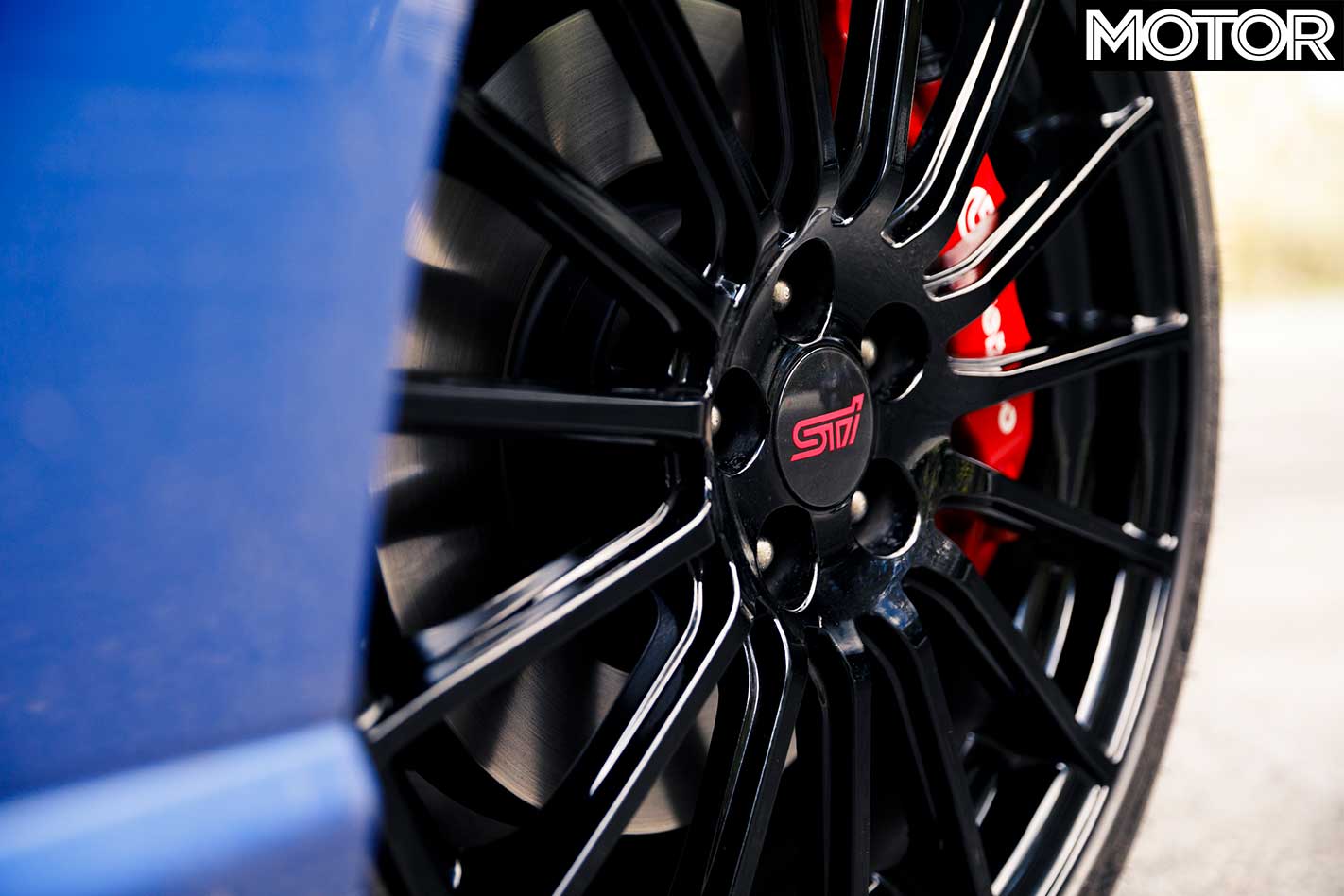
But it’s the Volkswagen that has changed most, at least on paper. It has bulked up during the off-season to grow in width, wheelbase and length. The shell has been stiffened to help its upgraded steering motor, tougher bushings and thicker roll bars, and unique front knuckles sharpen its reflexes. It scores stiffer springs and in Australia we get adaptive dampers as standard.
The brakes and tyres are fairly run of the mill, with Michelin Primacy 3s wrapped around 17-inch wheels and single-piston calipers. There’s no LSD, either. It all features on a scaled-down version of the Golf GTI’s platform, and adds a rear torsion-beam, to weigh 1285kg tare.
Price-wise it’s serious bang for your buck. At $30,900 it’s almost line-ball with the old DSG-equipped version, and although we’re told a manual one will be built, it’s predicted to skip our shores. This is due to a new EU petrol particulate filter that doesn’t like our sulphur-rich fuel.
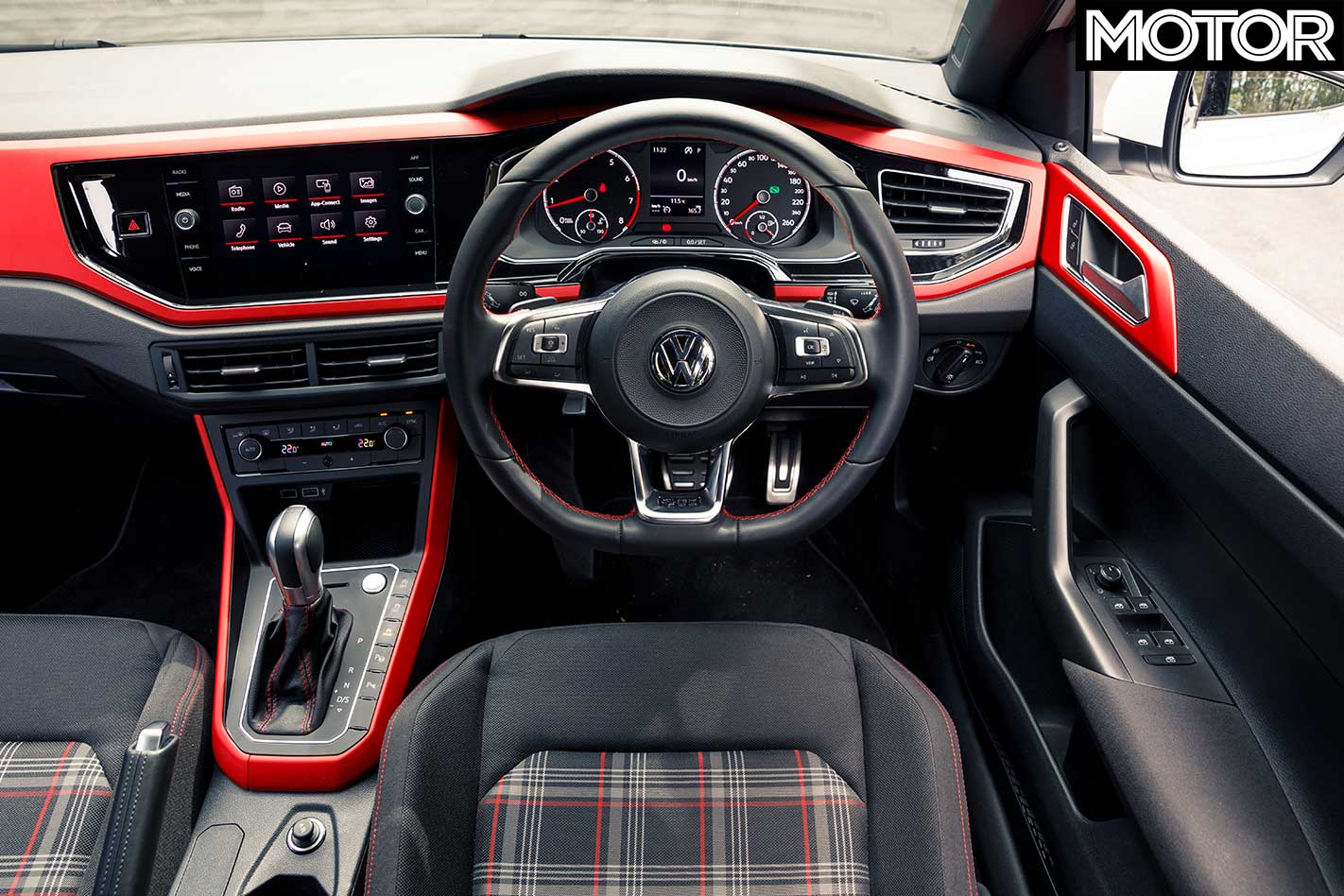
VW needs a solid business case to build a powertrain without one, but since Aussies are buying fewer manuals than ever – only one in 10 of you went for the self-shifter in the Golf performance range – that lessens the chance of one coming here.
So it’s solely a six-speed dual-clutch gearbox for now that helps its turbo four pump 147kW and 320Nm to the front wheels. What’s more surprising than Volkswagen’s decision to up its engine size when others are downsizing is the small gain that results from the extra capacity.
The torque band is more or less the same, swelling from 1500rpm until 4400rpm, but it’s only 6kW up on the old manual model. That said, the 2.0-litre feels less strained than the old 1.8, whistling along as if it’s running on minimal boost. And it’s now making its 147kW over a wider rev range as well.

Unlike the old seven-speed DSG, the six-speed handles the torque with ease, accepting shifts in any situation and matching what feel like widespread ratios to a tractable torque curve. It delivers its thrust from as low as 2750rpm and keeps it up until the 6600rpm cut-out. There’s plenty of grunt to overpower the front axle from a standstill, traction control on or off, and turbocharging is clearly a crushing advantage in this company.
Despite the Polo’s Michelins struggling to contain all its torque, it will hit 100km/h from rest quicker than the claimed 6.7 seconds with launch control. On our first run at the dragstrip it hit 100km/h in 6.6sec and covered 400m in 14.8sec at 156km/h.
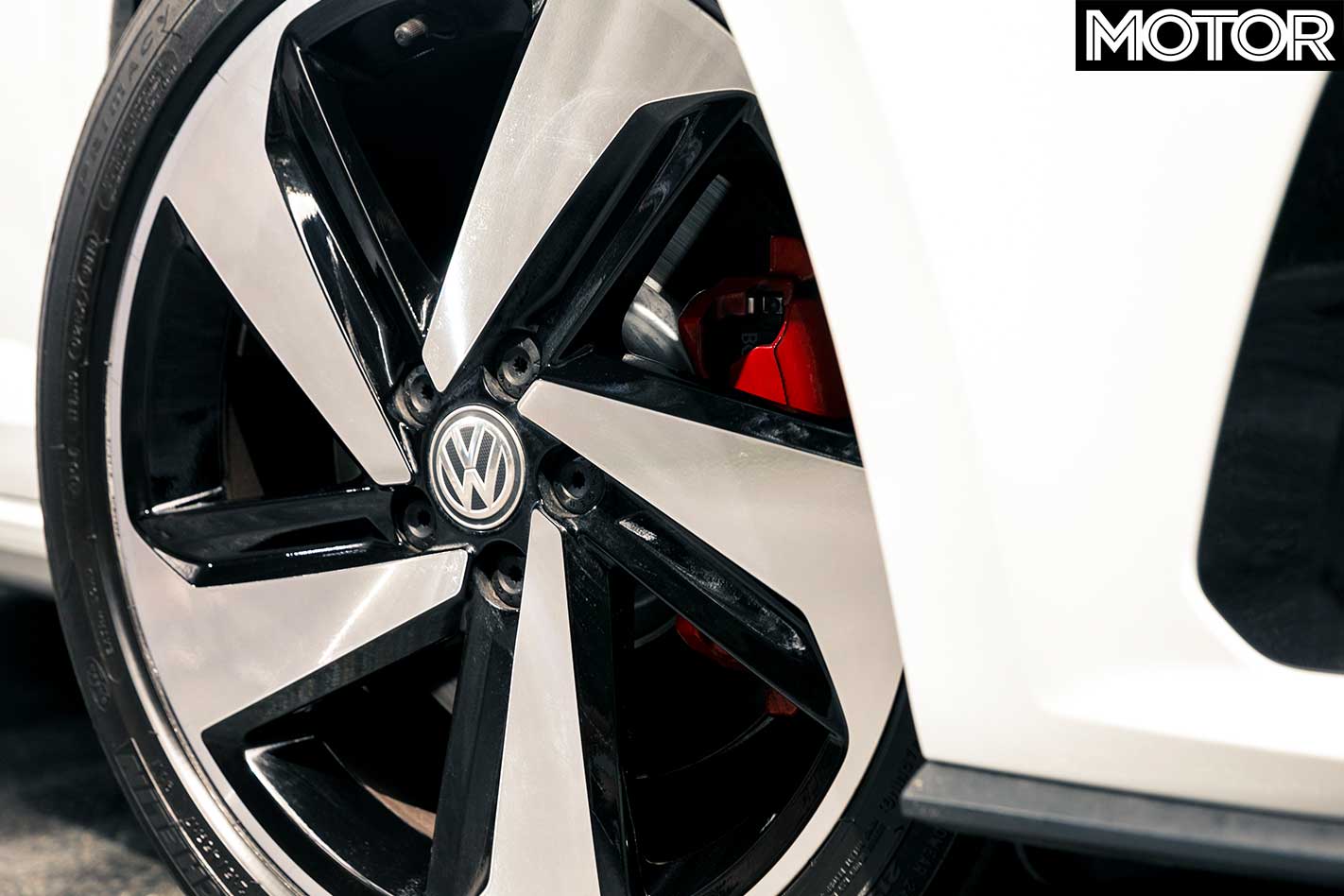
It’s scrappy off the line, though, and wheelspin quickly becomes axle tramp until the traction control calms things down. It’s only when you switch the electronic stability control to Sport mode that it grips up and logs a 6.15sec run to 100km/h and a 14.45sec sprint over 400m. Times like that promise to give a new Golf GTI a good arm wrestling.
BRZs need a good run-in before they can match their claimed acceleration times, or beat them if we’re being hopeful, and our test confirms that this particular example, fresh from Subaru’s marketing fleet, has its best days ahead of it.
We initially bog the launch and mis-shift from third to fourth, revealing how easy the Volkswagen launch control made it for us. The result is a dismal 8.0sec 0-100km/h run and 15.8sec pass.
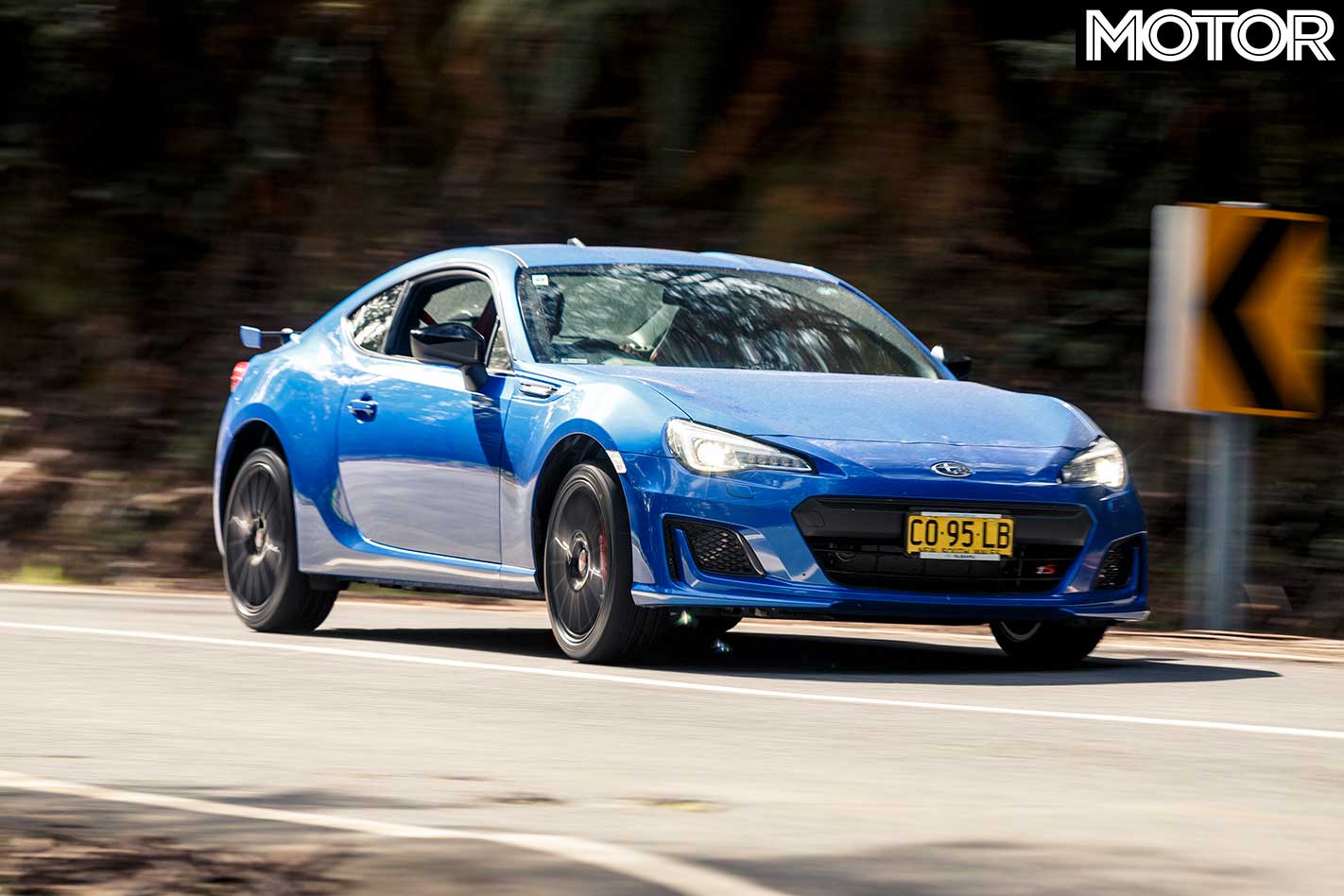
It’s a worrying start for the car with the highest power-to-weight ratio, and its dual fuel injection system is part of the problem. It spoils a nice mound of torque low in the rev range and a satisfying pull to its 7400rpm redline by plonking a hole in the middle of the delivery. Although every pull ends with a nice, positive shift, the drop created when the injection strategies switch over sucks the fun out of staying in gear.
However, there’s still something to be said about Subaru’s craft in eking 152kW and 212Nm from just 2.0 litres. After all, with bigger intake and exhaust runners since last year, dual fuel injection, variable cam timing and variable valve lift, it’s still a high-tech piece of kit.
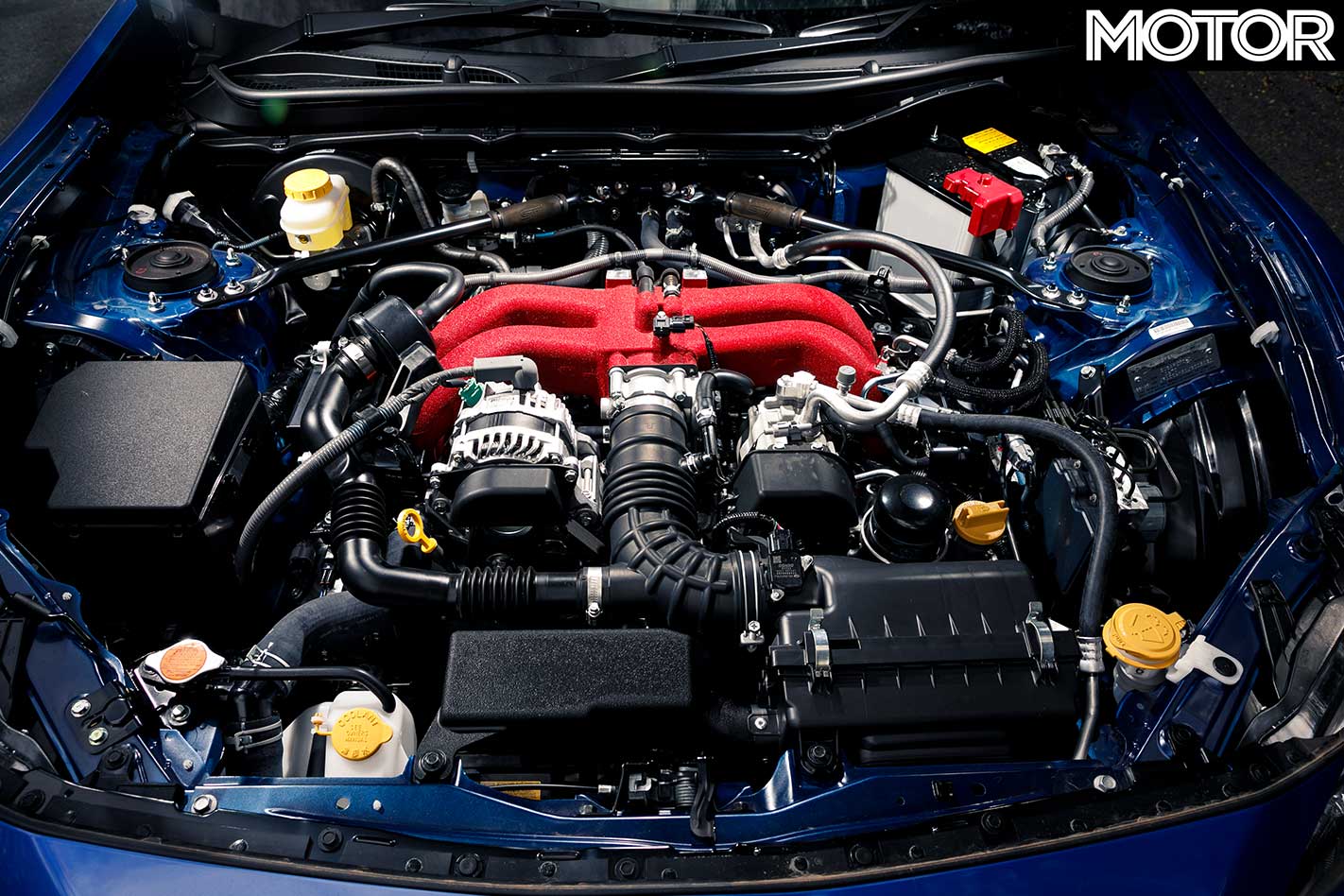
Getting away from the line in a standard BRZ requires plenty of revs and slipping the clutch – which, by the way, is not exactly full of bite – and the stickier Pilot Sport 4s make the job even harder. A quick step off the clutch at around 5500rpm finally gets it singing. There’s a touch of wheelspin and we eventually extract 7.58sec/15.33sec at 148.6km/h. That’s still more than 1.0sec and 7km/h adrift of the less-powerful Polo.
The Mazda finds itself somewhere between these two extremes. It might not have the muscles of the other two, but it throws a good punch. The car’s torque peak appears 600rpm earlier than the old 2.0-litre engine, while max power arrives 1000rpm higher at 7000rpm. And since Mazda has stuck with direct injection, there’s no torque hole between them, only a straight climb towards that peak.
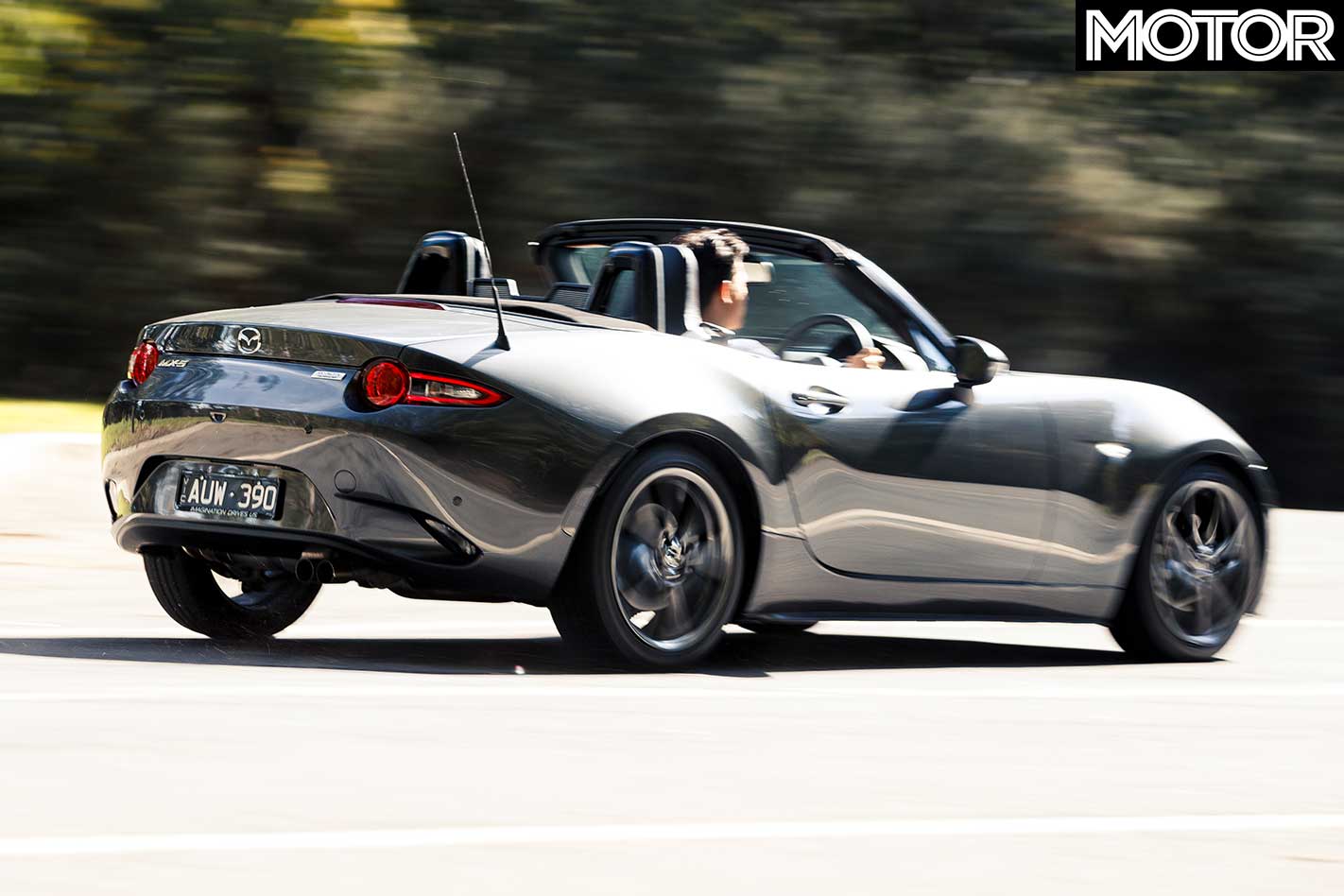
Response is also a strong suit, as each millimetre of throttle changes the car’s attitude and velocity. It’s a complete contrast to the binary throttle applications needed in the Subaru’s mid-range and makes getting off the line easier. You’ll still need about 5000rpm on board to spin the rear tyres enough for a decent launch, but its weight helps it get moving. Our first run easily nets a 6.8sec 0-100km/h run and 14.9sec 400m pass.
On top of a higher redline increasing noise and power, it lifts the top speed in each ratio to nudge the car past 100km/h in second gear. Timing the shift is key, though, as bouncing off the cut-out will cost you precious tenths. Slice through its delicate six-speed transmission and it’ll reach 100km/h in 6.67sec and 400m in 14.77sec at 150.8km/h.
While the Mazda’s light rear-drive layout helps it on the strip, it’s also what makes it brilliant when the roads start to wind. With no need for rear seats, the MX-5 fits its entire engine behind the front axle line. Mazda claims it’s perfectly balanced front to rear even with the 2.0-litre.
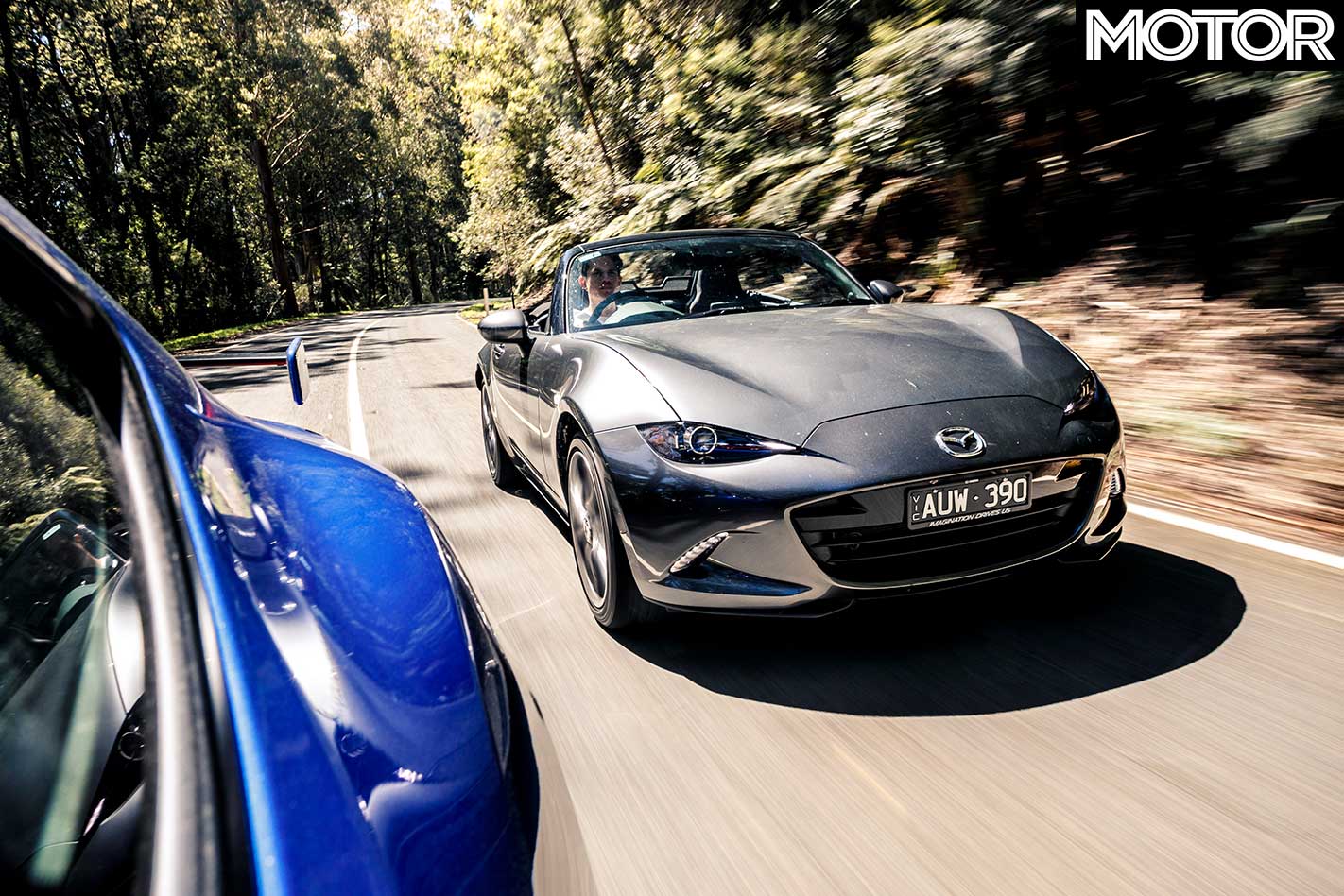
Riding on double-wishbone front and multi-link rear suspension, it floats into corners as the most neutral of the three. Like a bantamweight fighter, it darts around on its heels. At that uphill left-hander we mentioned at the start of this story, the Mazda can be steered on the throttle for much of the climb up the hill. You barely need to lift and its Bridgestones have so little centrifugal force to fight in the corners.
Understeer is hardly a problem for the BRZ, but its layout doesn’t have the same level of purity, and you can feel this play out on the road, where you need more front grip to turn in. You then lift earlier or dab the brakes where the MX-5 would sail past carrying its momentum.
But while a portion of the BRZ’s engine sits ahead of the front axle line, it isn’t any taller than the front wheels. Should your drive route change from flowing third-gear corners to tight second-gear bends then the BRZ’s hunkered-down chassis, bolstered by lowered springs, clings to the surface much better than the rest.
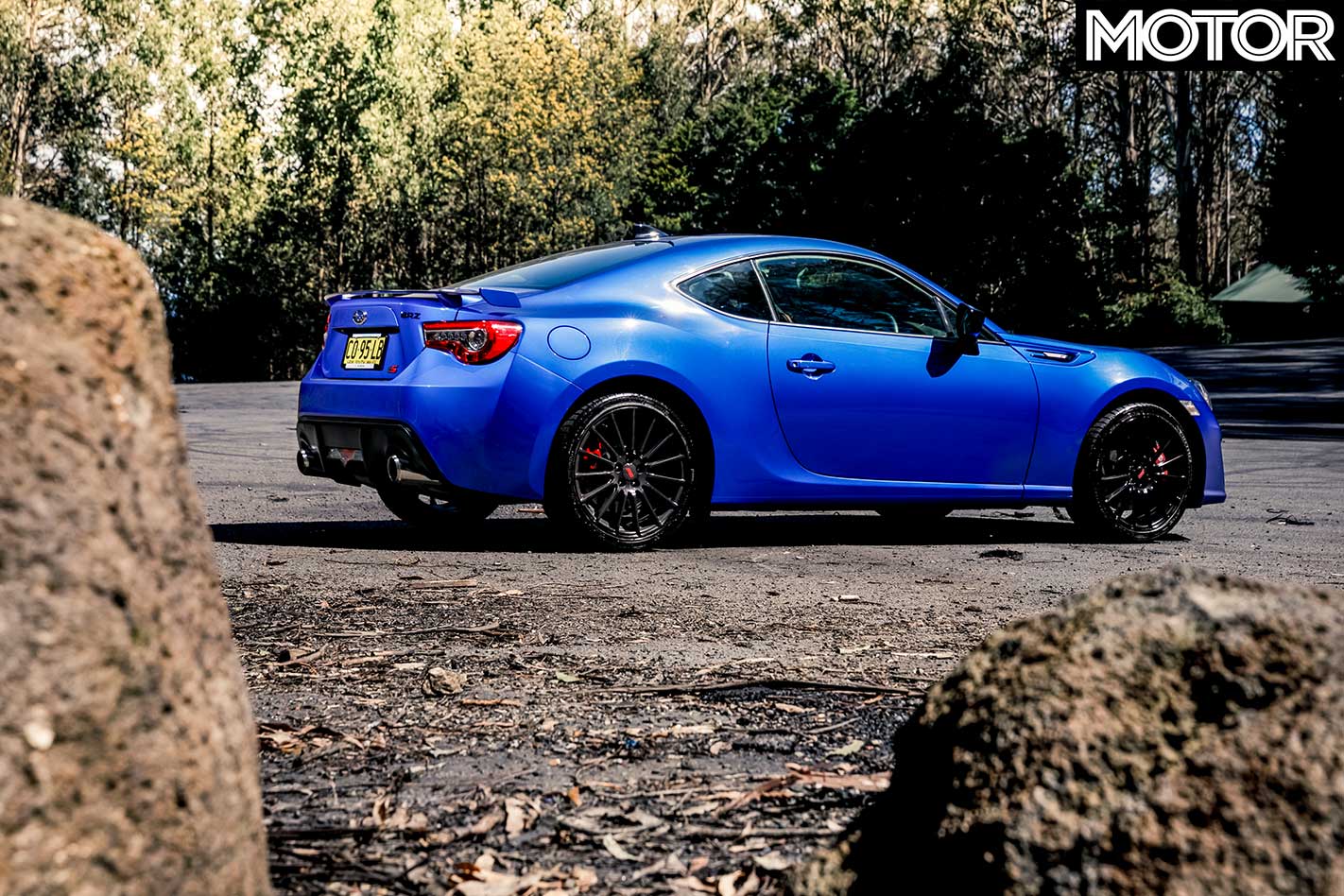
Switching into the Polo reveals how much duller front-drive can inherently be. You wait longer for the front-end, and to use the brake and throttle. But the new platform responds well when driven hard, feeling more planted than the last version and extracting a good amount of grip from a modest tyre in the Michelin Primacy 3.
That outside front tyre stays velcroed to the road even on tightening bends, but the Polo begs you to ease up on it, as it can’t dance like the other two. Since it matches big outputs to average brakes and tyres, there’s more energy to consider into each corner and you often find yourself waiting on its mass to settle on the outside tyres.
The flipside to this is that its adaptive suspension absorbs mid-corner lumps well. Even in Sport mode there’s always travel up its dampers’ sleeves. The relatively soft Mazda isn’t as unflappable over bumps, but it’s more controlled than the BRZ, which has a touch more rebound.

But while the BRZ is heavier, it demands you to drive it before you judge that flabbier size. It feels a little firmer and a touch more precise than the MX-5. The gains in accuracy are down to those bars that reinforce one of the most positive front-ends in the business. That said, it’s not as cohesive as the MX-5, which has a slower, but just as precise, steering rack and encourages you to use its chassis to help steer the car instead.
The Polo’s steering rack, meanwhile, feels like a carbon copy of the Golf GTI’s crisp, accurate electric system. It’s a big step up over the previous version. It’s also the only car here that can modify its steering heft, though the extra weight in Sport doesn’t make it any friendlier.
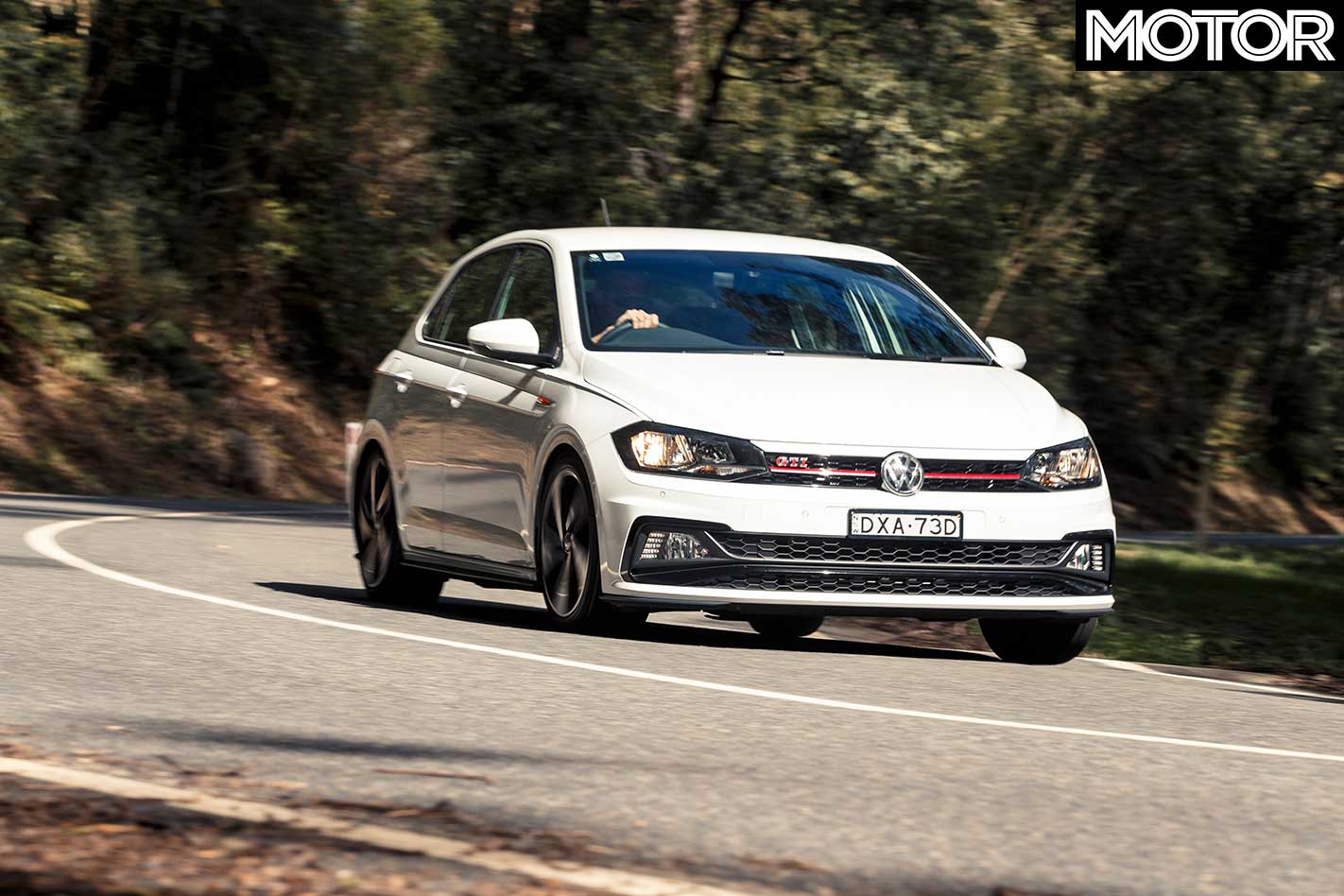
The BRZ might be one of the few cars in which you enjoy using the brake pedal more than the throttle, at least for feel. It has lot of feedback and gives you confidence to put the BRZ on its nose into corners.
The Mazda’s single-piston hardware might not have the piston-on-pad feel of the Subaru but it’s just as effective, helping to balance weight on its front-end if need be. It’s only the Polo’s brakes that are found wanting. Not only are they hard to judge, but on the downhill pass they turn into a smoking mess. It’s worrying that they also need to do more than just slow the car down.
Volkswagen uses its XDS technology, which stands for Extended Differential Lock, on the front axle. Although there’s nothing locking except the inside brake caliper, it works quite well in place of an LSD. You barely notice it pumping the inside brake; the operation is much more refined than most systems and helps you apply its power more smoothly on corner exit.
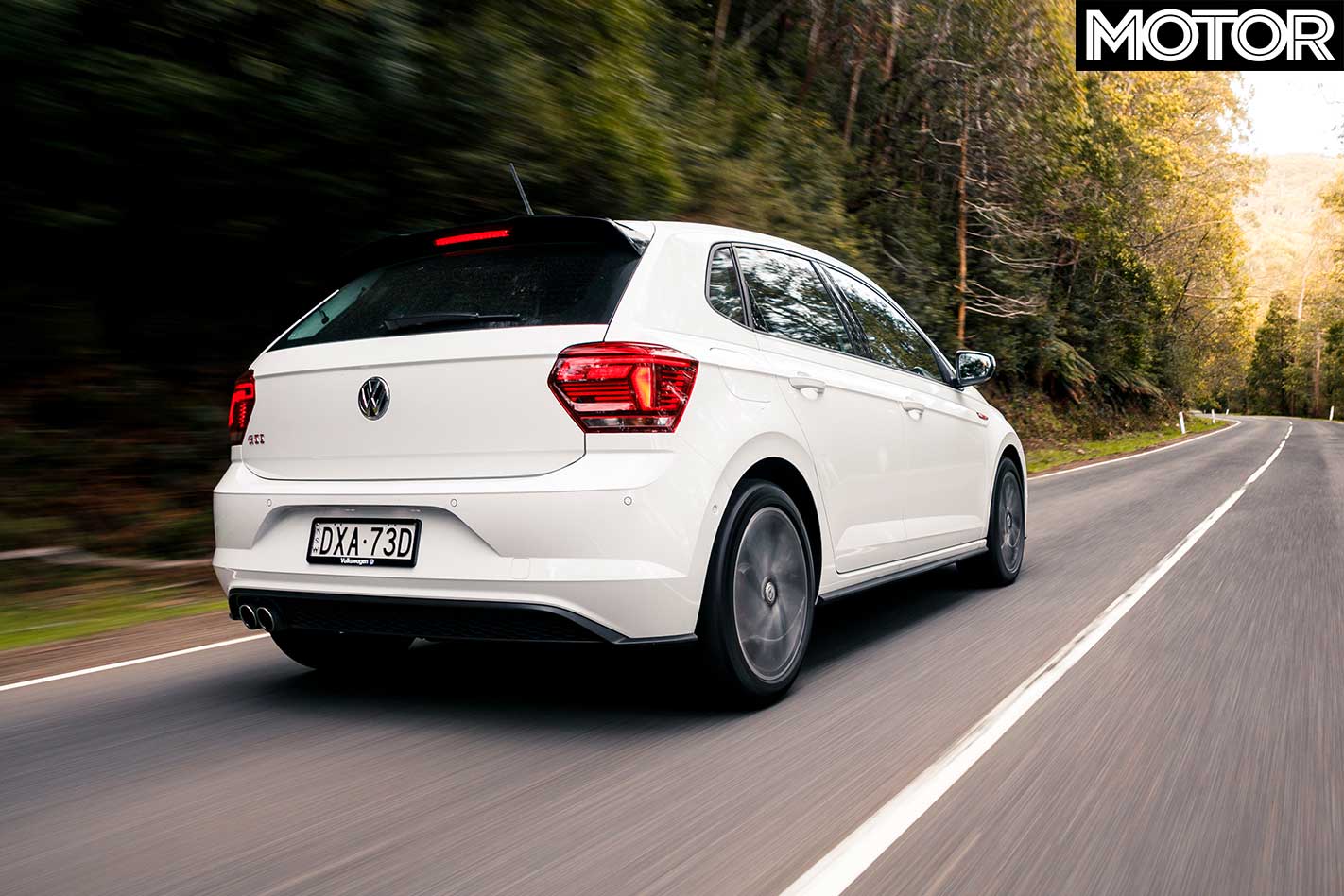
This is rarely a problem in the BRZ, of course, except in low gear, high-rev corners where it can be provoked into oversteer when you’re in the loosest ESP setting, or have it switched off. It’s planted, stable and always in control.
Rear grip is also plentiful in the Mazda, and while it’s now got a bit more power, it’s not nearly enough to have a real affect on its grip balance. The changes to the rear suspension have, however, smoothed the transition into roll oversteer, but you’ll have fun testing those limits, even if just for the sound.
The MX-5’s extra engine speed lets it hold gears on steep climbs, and as it cranks up revs the sound develops into a full-bodied roar. Here, the percussion of its valves, cam lobes, and pistons becomes hard-edged and musical, without any of the harshness or vibration of the old 2.0-litre SkyActiv unit.

Meanwhile, the BRZ isn’t as nice to run to the last rpm, but the howl from the acoustic generator that manipulates intake air helps build suspense.
The Polo, though, is much more subdued. You have to listen close for the small choofs from the turbocharger, the muffled pops on overrun and a nice rort. They suit it.
But they need to. GTIs have built a reputation on accessibility, sophistication and practicality, and the Polo clearly values those things most. Even the incoming Fiesta ST has heeded the Polo’s steadfast focus on class and has been heavily upgraded in that area. The VW’s interior is the slickest here and, while the car is inherently practical, it’s also fast enough in a straight line to match a Golf GTI’s claimed acceleration times.

But the Polo GTI can only do so much. When you start to push on, suddenly it feels twice as tall as the others. It’s the most pliant car, but it’s low-speed ride isn’t all that much better than the others. That would be acceptable if it set a winding road on fire, but it doesn’t. Only its brakes.
Speaking of which, at 1285kg tare (which means empty but with fluids), the Polo is starting to creep up in size. Yes, it needs to seat five, but we need to draw the line on what makes a small hatch, well, small. On the other hand, its bigger spread of grip has made it a better handler, but we suspect the new Fiesta ST will be the go-to for razor-sharp responses.
And if that’s what you really want then you could just buy the BRZ tS. At $39,894, it costs as much as a Polo GTI fully optioned. Sure, it won’t have a chance in a straight line, but its extra grip has enhanced rather than spoilt the car’s core characteristics.
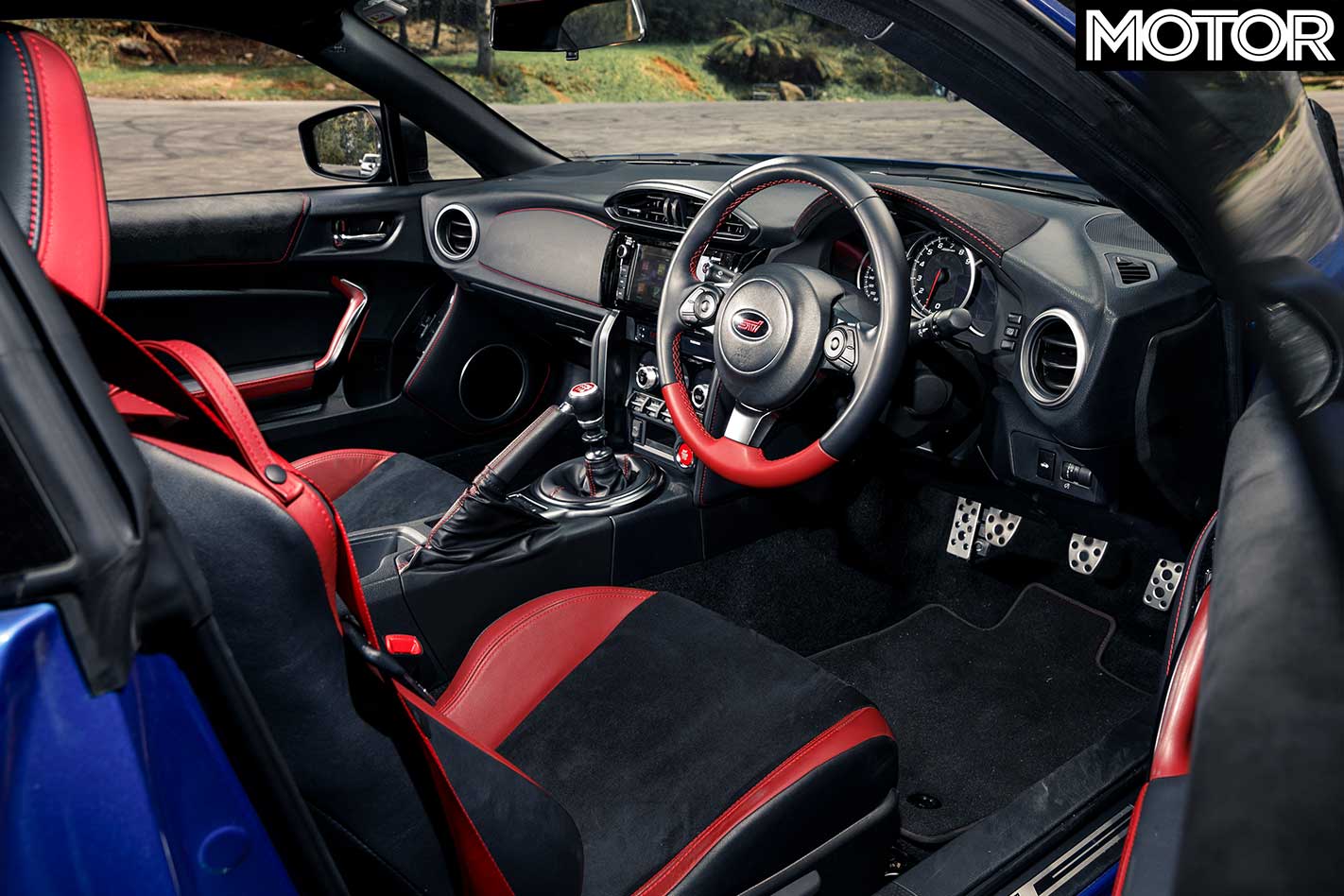
A lot of charm already existed in the base car, but the tS’s unique Sachs dampers give the BRZ a better ride to make it more believable as a day-to-day chariot. And we don’t doubt you could drive to a track, bang out laps all day, only to have the car lap it up and take you home with a smile on its face. We like the interior’s infotainment system – it’s even better than the Mazda’s faux iDrive arrangement – and it’s also got rear seats and a decent boot to get you out of trouble.
But where the Mazda’s going, you don’t need luggage. It’s hard to quantify its appeal on sheer numbers, or price, as it is the most expensive car here and perhaps the slowest on a racetrack. But that new engine and tweaked chassis sprinkle brilliance on the MX-5’s already high appeal. Yes, it’s dearer. But one visit to its 7500rpm redline makes all other considerations, good or bad, fade away.
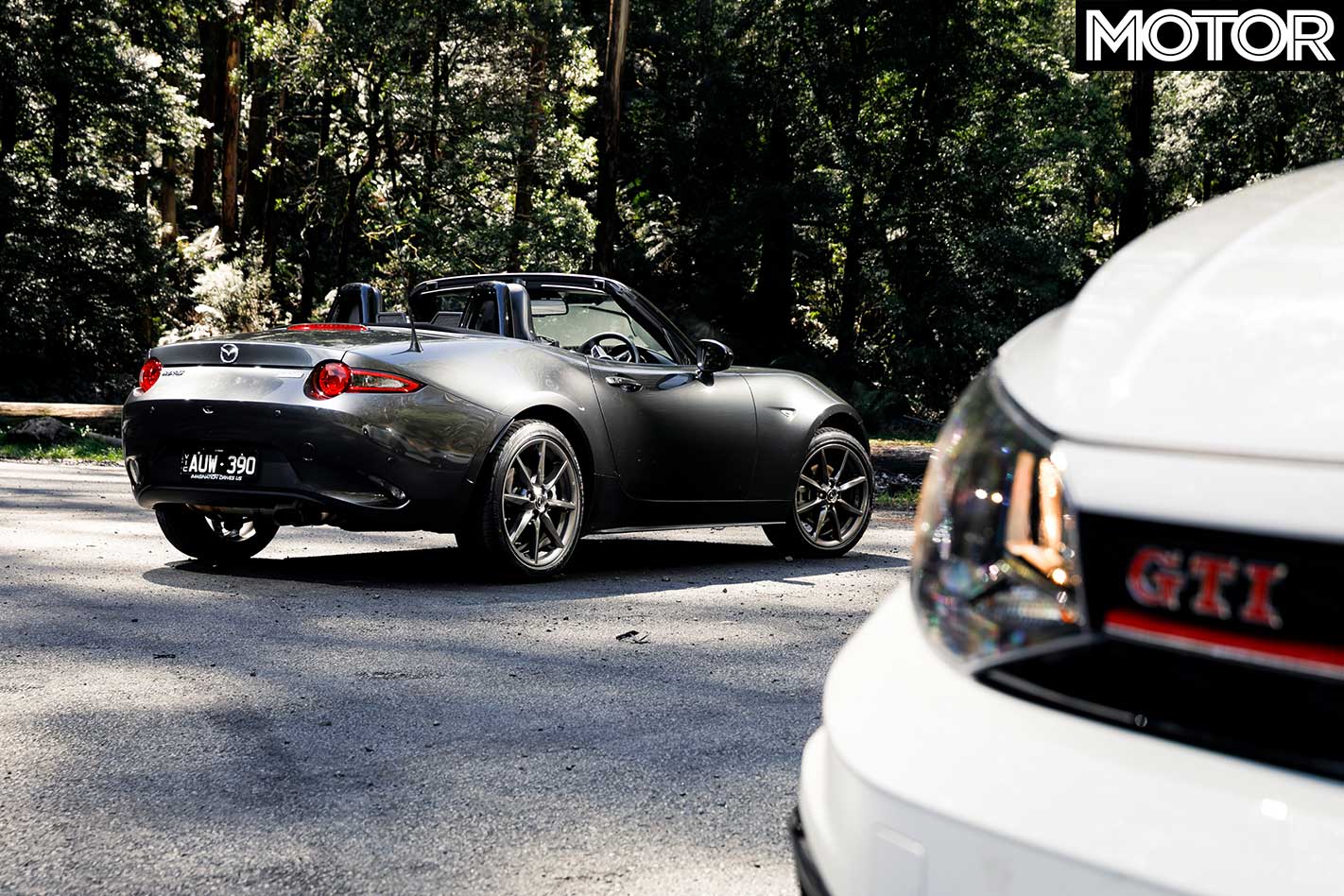
Caning the MX-5 on a clear, warm day with nothing but winding roads ahead of you is one of motoring’s greatest pleasures. And, as you’ll find out at the bowser, it won’t cost you much either. Even if you’ve spent the whole time taking corners with the throttle flat.
Fast Facts
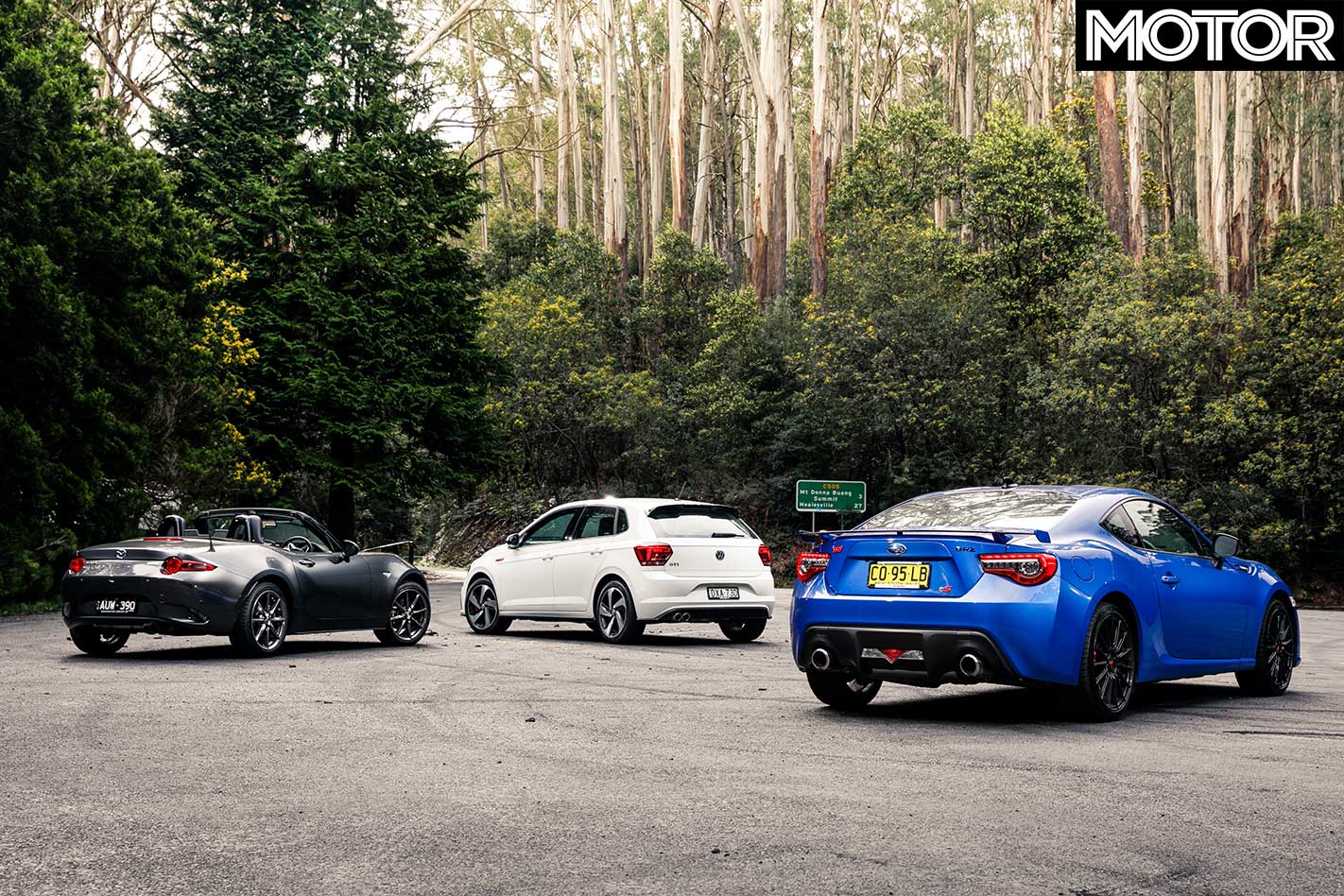
| u00a0 | Mazda MX-5 GT | Volkswagen Polo GTI | Subaru BRZ tS |
| Body | 2-door, 2-seat convertible | 5-door, 5-seat hatch | 2-door, 4-seat coupe |
| Drive | rear-wheel | front-wheel | rear-wheel |
| Engine | 1998cc inline-4, DOHC, 16v | 1984cc inline 4, DOHC, 16v, turbo | 1998cc boxer-4, DOHC, 16v |
| Bore x Stroke | 83.5mm x 91.2mm | 82.5mm x 92.8mm | 86.0mm x 86.0mm |
| Compression | 13.0:1 | 9.6:1 | 12.5:1 |
| Power | 135kW @ 7000rpm | 147kW @ 4400-6000rpm | 152kW @ 7000rpm |
| Torque | 205Nm @ 4000rpm | 320Nm @ 1500-4400rpm | 212Nm @ 6400-6800rpm |
| Power/Weight | 128kW/tonne | 114kW/tonne (tare) | 117kW/tonne |
| Transmission | 6-speed manual | 6-speed dual-clutch | 6-speed manual |
| Weight | 1056kg | 1285kg (tare) | 1295kg |
| Suspension | A-arms, coil springs, anti-roll bar (f); multi-links,coil springs, anti-roll bar (r) | struts, coil springs, adaptive dampers, anti-roll bar (f); torsion beam, coil springs, adaptive dampers, anti-roll bar (r) | struts, dampers, anti-roll bar (f); A-arms, dampers, anti-roll bar (r) |
| L/W/h | 3915/1735/1230mm | 4067/1751/1438mm | 4240/1775/1320mm |
| Wheelbase | 2310mm | 2560mm | 2570mm |
| Tracks | 1495mm (f);1505mm (r) | 1510mm (f); 1484mm (r) | 1520mm (f); 1540mm (r) |
| Steering | electrically assisted rack-and-pinion | ||
| Brakes (f) | 280mm ventilated discs, single-piston calipers | 310mm ventilated discs, single-piston calipers | 326mm ventilated discs, 4-piston calipers |
| Brakes (r) | 280mm ventilated discs, single-piston calipers | 272mm ventilated discs, single-piston calipers | 316mm ventilated discs, 2-piston calipers |
| Wheels | 17.0 x 7.0-inch (f/r) | 17.0 x 7.5-inch (f/r) | 18.0 x 7.5-inch (f/r) |
| Tyre Sizes | 205/45 R17 (f/r) | 215/45 R17 (f/r) | 215/40 R18 85Y (f/r) |
| Tyres | Bridgestone Potenza S001 | Michelin Primacy 3 | Michelin Pilot Sport 4 |
| Price | $41,960 | $30,900 | $39,894 |
| Pros | Zingy engine; frugal thirst; open-top appeal | Accessible, practical, sharp | Grip; brakes; point; infotainment system |
| Cons | Busy ride; unsupportive seats | Bit sensible; not as hardcore as some rivals | Lack of power; engine sounds meh |
| Rating | 4.5 out of 5 stars | 4 out of 5 stars | 4.5 out of 5 stars |
The Strip
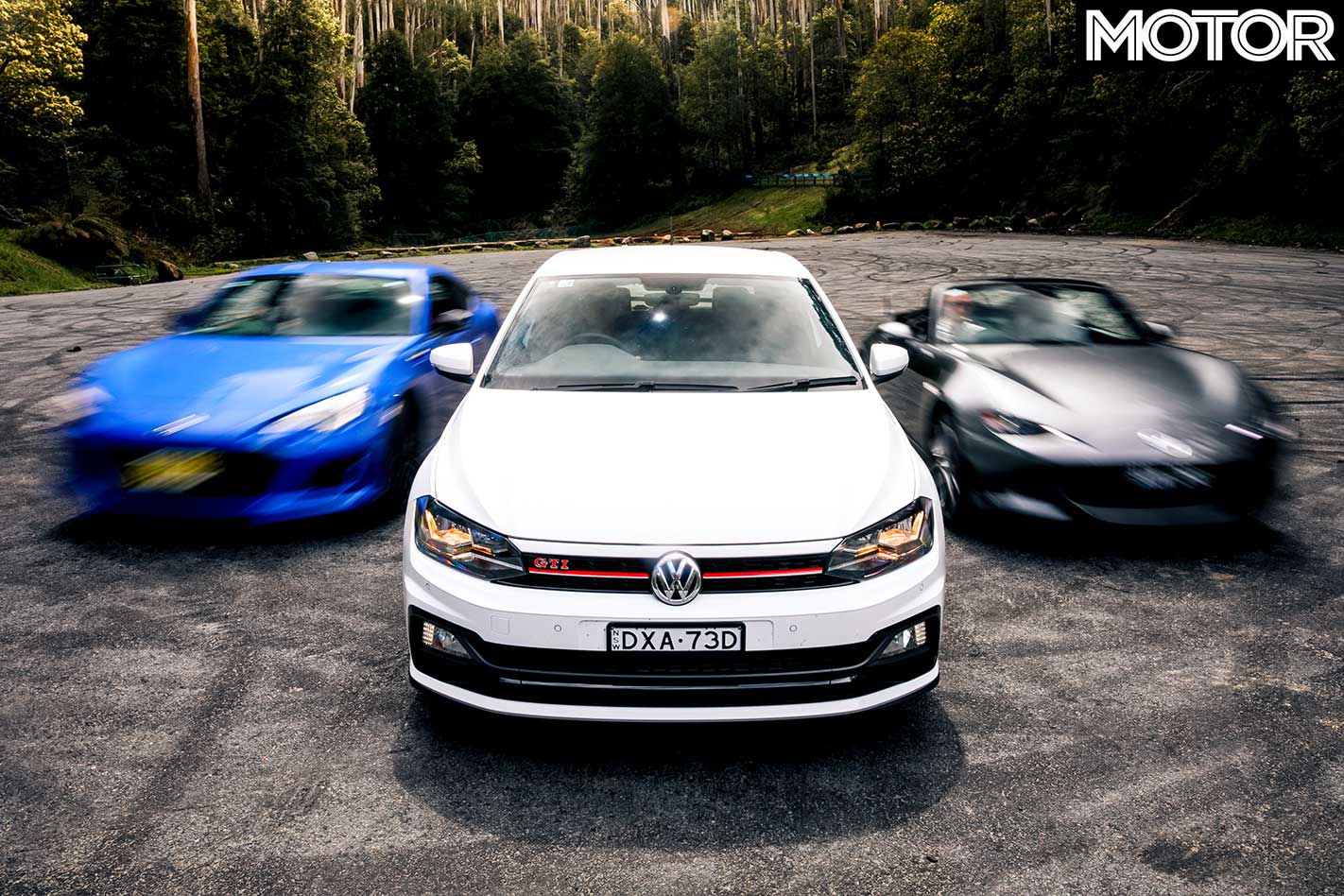
| u00a0 | Subaru BRZ tS | Volkswagen Polo GTI | Mazda MX-5 GT |
| 0-10km/h | 0.30sec | 0.39sec | 0.36sec |
| 0-20km/h | 0.86sec | 0.93sec | 0.85sec |
| 0-30km/h | 1.32sec | 1.37sec | 1.29sec |
| 0-40km/h | 1.89sec | 1.83sec | 1.71sec |
| 0-50km/h | 2.52sec | 2.41sec | 2.20sec |
| 0-60km/h | 3.46sec | 2.92sec | 3.10sec |
| 0-70km/h | 4.33sec | 3.59sec | 3.77sec |
| 0-80km/h | 5.24sec | 4.39sec | 4.56sec |
| 0-90km/h | 6.16sec | 5.23sec | 5.39sec |
| 0-100km/h | 7.58sec | 6.15sec | 6.67sec |
| 0-110km/h | 8.86sec | 7.21sec | 7.88sec |
| 0-120km/h | 10.16sec | 8.45sec | 9.13sec |
| 0-130km/h | 11.90sec | 9.89sec | 10.48sec |
| 0-140km/h | 13.70sec | 11.46sec | 12.13sec |
| 0-150km/h | 15.33sec | 13.14sec | 14.58sec |
| 0-400m | 15.33sec @ 148.64km/h | 14.42sec @ 156.51km/h | 14.77sec @ 155.99km/h |
| 80-120km/h (Drive) | 4.94sec | 4.01sec | 4.49sec |
| 100-0km/h | 35.23m | 37.52m | 35.72m |
| Speed in Gears | |||
| 1st | 56km/h @ 7400rpm | N/A @ 6600rpm | 60km/h @ 7500rpm |
| 2nd | 93km/h @u00a07400rpm | N/A @ 6600rpm | 102km/h @ 7500rpm |
| 3rd | 132km/h @u00a07400rpm | N/A @ 6600rpm | 149km/h @ 7500rpm |
| 4th | 168km/h @u00a07400rpm* | N/A @ 6600rpm | 191km/h @ 7500rpm* |
| 5th | 204km/h @u00a07400rpm* | N/A @ 6600rpm | 219km/h @ 6950rpm* |
| 6th | 216km/h @ 6020rpm* | N/A @ 6600rpm | 219km/h @ 5395rpm* |
Heathcote Raceway, 16˚C, dry. Driver: Louis Cordony *Manufacturer’s claim Official timing supplier: www.vboxaustralia.com.au
Factory-bred Motorsports siblings
1 – Volkswagen Polo GTI R5
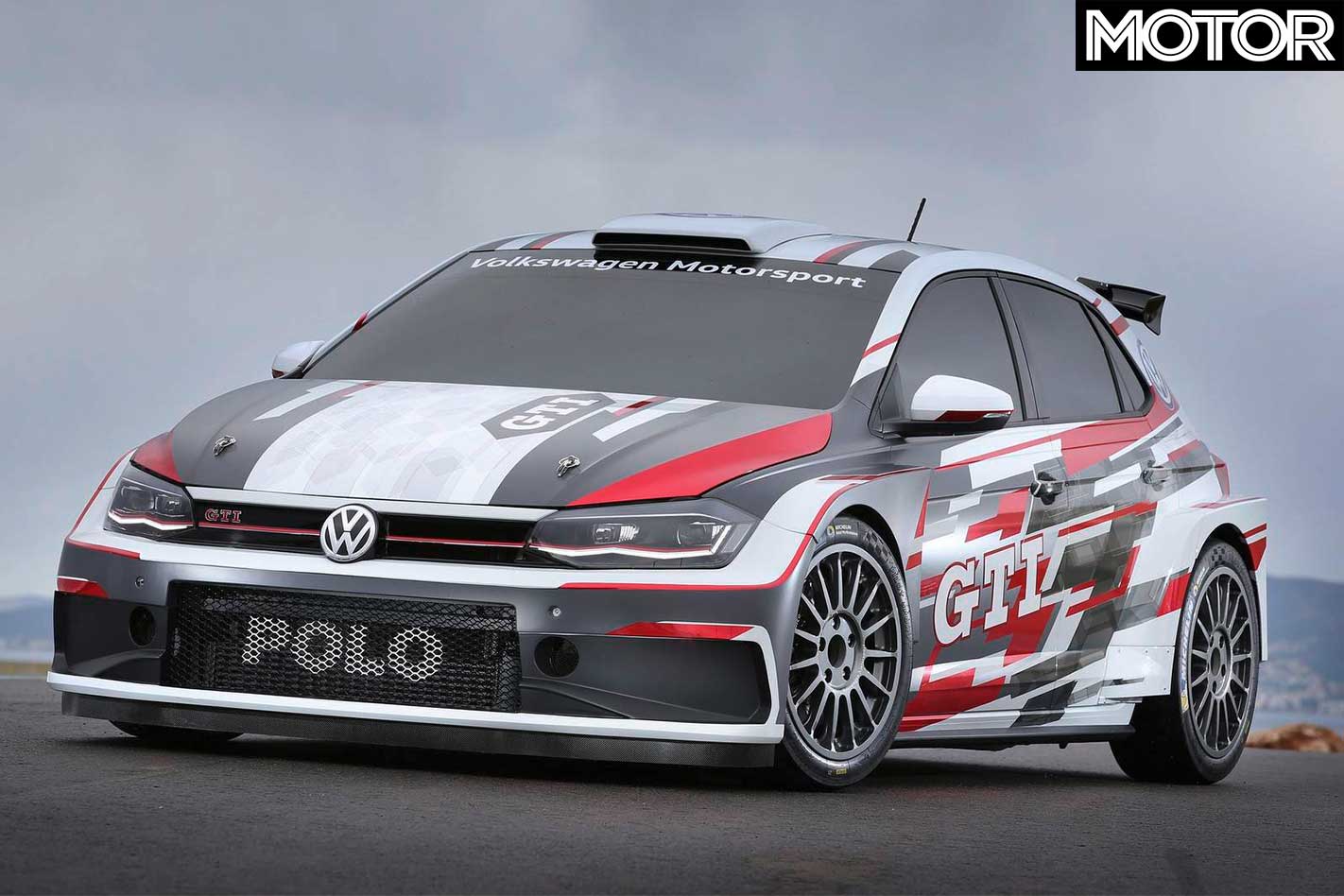
The baddest Polo of them all is the rally-spec R5. Built by VW Motorsport in Spain for customer racing, it features all-wheel drive, a 200kW/400Nm turbo 1.6-litre four and a sequential transmission. It’s good for 0-100km/h in 4.1 seconds and has all the requisite safety modifications and bodywork for rallying, along with ZF dampers and two clutch LSDs. It’s also expensive at €190,000 (AUD$298,000).
2 – Mazda MX-5 Cup car

Keen to carve out a name for yourself in USA’s one-make series circles? Mazda’s MX-5 Cup car would be for you, then. Built in America for a ‘global’ series, they’re left-hand drive, use a sealed 2.0-litre engine and extensive chassis upgrades. DSSV dampers hold BF Goodrich slicks on the road. Cost is USD$58,000 for the 2018 car (AUD$80,000), but the new version with a 7500rpm engine bumps that to USD$65K (AUD$89K).
3 – Subaru BRZ RA
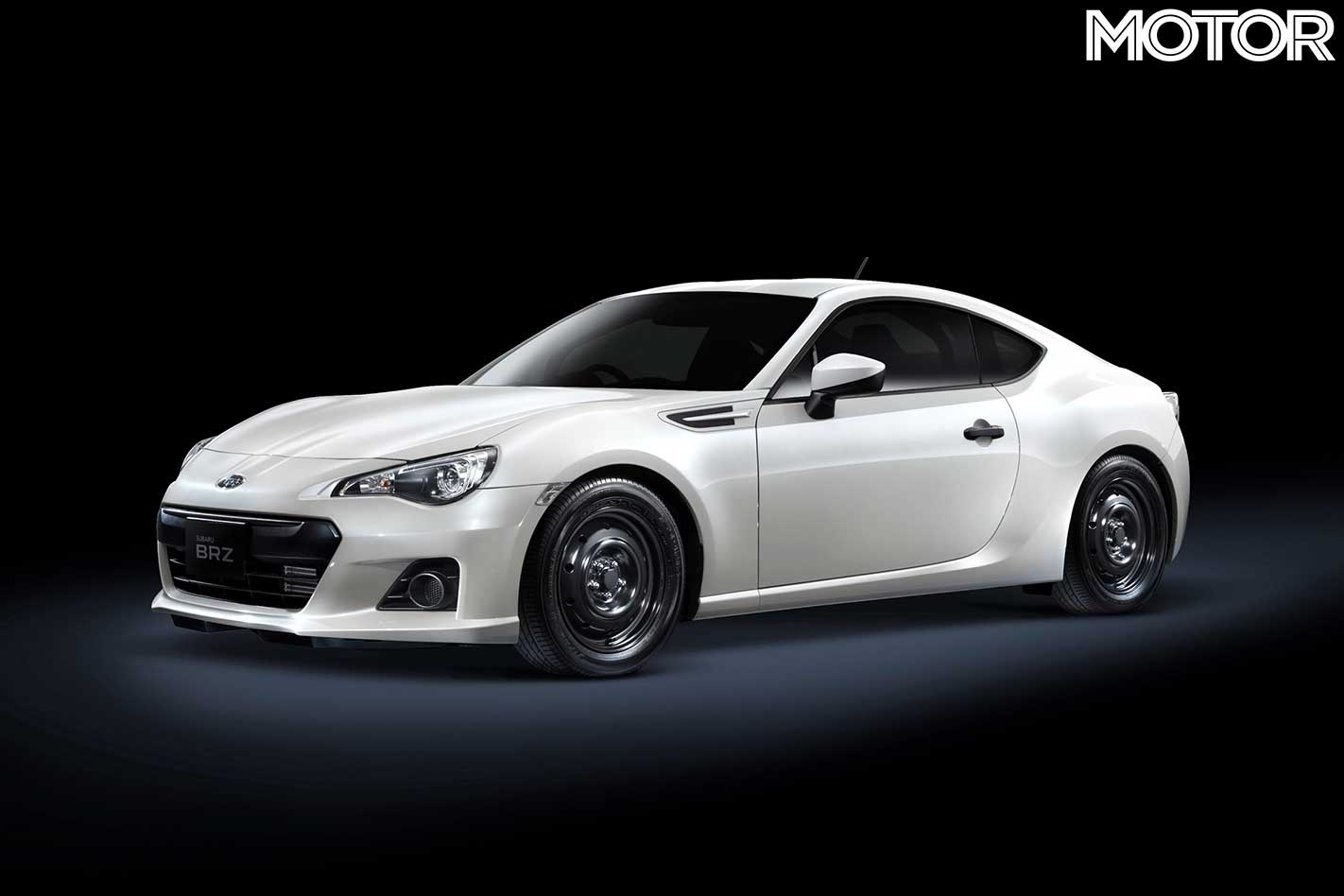
Okay, so not all of us want to dive straight into competition motorsport. Then what about track days? The Japan-only BRZ RA junks items that add unnecessary cost – note those steelies that Subaru assume you’ll throw out anyway – and its price converts to AUD$26,000. Or you can go for the RA Racing version that adds a six-point roll cage, oil cooler, harnesses and brake cooling ducts for about AUD$38K.


